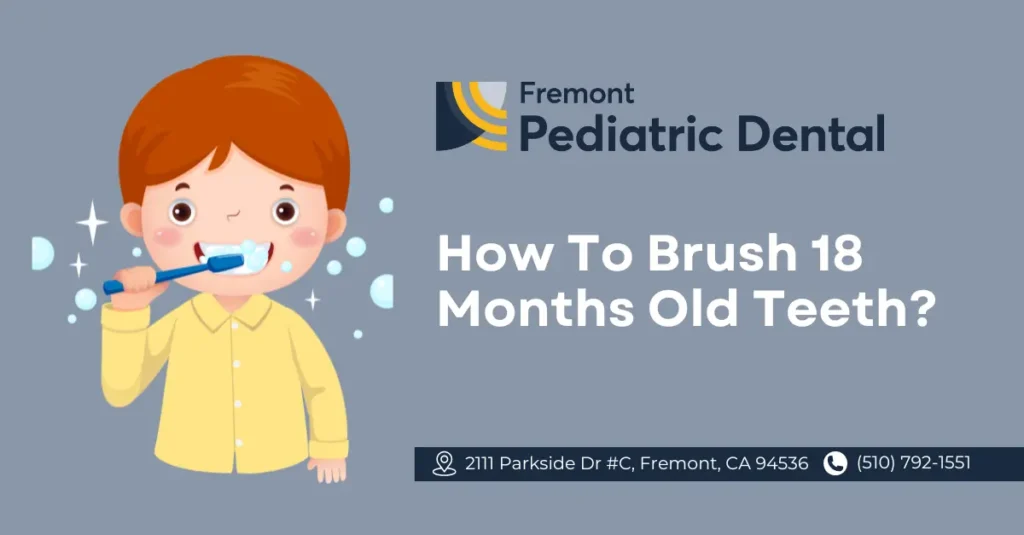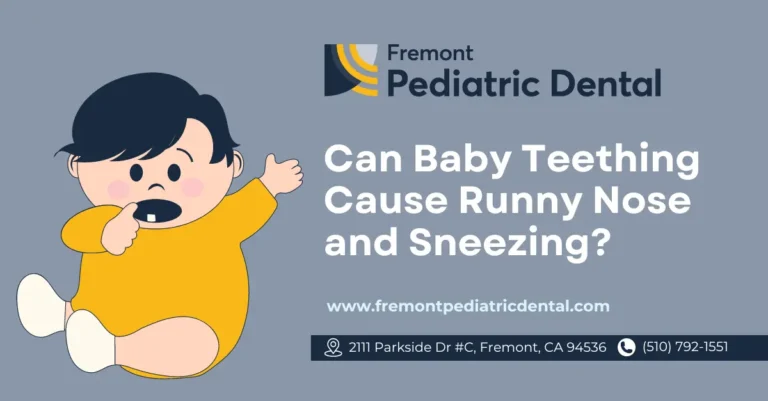Brushing your 18 month old’s teeth is an essential part of maintaining their oral health and establishing good hygiene habits early on. At this age, children typically have several primary teeth, also known as baby teeth, which require regular dental care to prevent cavities and other dental issues.

Before answering the main question i.e. how to brush 18 month old teeth, it is important to understand which teeth come in around 18 months can help you better care for your child’s developing smile.
What Teeth Come In At 18 Months?
When your child gets 18 months older, they usually have their central incisors, lateral incisors, and first molars erupted. Although teething can occur at variable times, generally lower ones erupt earlier than the upper ones, following a sequence from centrals to first molars, then canines, and second molars. If your child has a normal eruption sequence, all 20 baby teeth arrive by the age of 3 years.
If you’re looking for a gentle dentist in Fremont, our pediatric dentist in Fremont, CA can help ensure your child’s teeth are well cared for during this important stage. As a pediatric dentist in Fremont that accepts medical, we understand the unique challenges parents face in maintaining their toddler’s oral hygiene.
Primary teeth, when not brushed properly, start decaying and eroding earlier. It is necessary to add morning and nighttime routines of brushing your 18-month-old’s teeth, as it sets a foundation for their future dental health.
Parents face multiple problems in taking care of their toddler’s oral hygiene. It is often due to their tantrums, refusal to brush, or excessive sweet intake, which leads to increased tooth decay. If you need assistance, finding a dentist in Fremont, can provide helpful resources for managing these challenges.
To help you out, we’ve brought some useful tips for you on how to brush your 18-month-old’s teeth while managing their daily tantrums to care for their oral health and develop good oral hygiene habits.
Tips on How to Brush 18 Month Old Teeth Properly
If you’re struggling with your child’s brushing challenges, you may need to try better strategies to brush their teeth properly and maintain their dental health. Here’s how you can do it:
1. Get onto the Right Position
Your position and your toddler position play an important part in the effectiveness of brushing. It should be in a way that your child feels independent and entertained, but you’re the one who is doing their job.
Try those positions in which your hands stay free. One for holding the toothbrush and the other one for pulling their lips back to reach the teeth better.
Here are some of the effective positions you can try:
- Keel behind your child standing, and hold them around the tummy or a hugging way to brush their teeth. Standing them in front of the mirror will make them curious about what’s happening inside their mouth to help them learn and give you a clear image of their gums and teeth.
- Sit on the floor and couch and lay your child’s head in your lap to keep them entertained with sweet words or storytelling while brushing their teeth easily.
- You can also get help from their comfort person by laying your child on their knees, who can keep them calm and comfortable while you brush their teeth.
2. Choose the Right Toothpaste
Your selection of toothpaste should be fair enough to fit your child’s fluoride intake requirements according to their age. When your child gets 18 months older, you can buy the least-containing fluoride toothpaste to avoid the chances of dental fluorosis.
Only use a tiny smear of paste (up to a rice grain size) for your 18 month old teeth brushing, and you can increase the amount to pea-size after the one turns 3. Don’t let your child swallow the paste and train them to spit quickly as soon as their mouth can’t hold it.
You may also want to know can teething cause a runny nose and sneezing?
3. Get the Right Toothbrush
It’s important to select a child-friendly toothbrush, designed for children aged 1-3 years. Such toothbrushes have soft bristles, small heads, and non-slip handles that make them suitable for small white pearls.
It is better to involve your child in its purchasing to help them select their favorite colored toothbrush (having characters or fun designs), which will make the whole brushing process fun.
Moreover, you can buy an electric toothbrush for your kids to have a more easy 18 month old teeth brushing experience, which you only need to place on their teeth, and it will automatically clean up the plaque effectively.
Note: You should replace the toothbrush as soon as the bristles get frayed/worn off or precisely every 3-4 months.
4. Follow the Right Brushing Technique
Keep the brush at a 45-degree angle and use small circular, vibratory motions on one by one of their teeth to clean their outer and inner surfaces. Apply short back-and-forth motions to brush the chewing surfaces, which is the main point of food sticking. Keep brushing for 2-3 minutes to reach all the tooth surfaces.
Moreover, brush on the gums with slight pressure where teeth have not erupted yet or use a damp cloth to clean them. Don’t forget to gently brush the tongue at least once a day, to avoid bacteria accumulation and bad breath!
Note: Maintain a routine of daily brushing twice a day to make it their forever habit.
How To Manage Your Child’s Teeth Brushing Tantrums?
Most of the children always say ‘no’ when it comes to brushing their teeth. But, you don’t need to worry about it as we’ve lined up a few best tips to manage it effectively:
Don’t wait for the mouth to be filled full of white pearls. Let’s take care of your child’s 18 month old teething with proper strategies to ensure their good dental health and keep their smiles brighter for a lifetime.
Try comfort and fun things to develop their perfect tooth-brushing routine twice a day. Show patience to make things go slowly while managing their tantrums effectively. Go smart and make your child fall in love with brushing!
With our pediatric dental services, we’re here to support you in nurturing your child’s dental health every step of the way!

